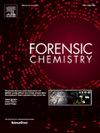结合化学探测器和SPME-GC对气相中指定i类化学物质进行实时监测和验证
IF 2.6
3区 医学
Q2 CHEMISTRY, ANALYTICAL
引用次数: 0
摘要
结合化学检测器AP4C火焰光度检测器和气相色谱-火焰光度检测器(GC-FPD)结合固相微萃取(SPME)技术,设计了一套可靠稳定的蒸汽发生器和干扰混合测试装置,可生成低水平标准CWAs蒸汽,并进行实时监测和验证。神经毒剂(GA、GB、GD和GF)和起泡剂(HD)蒸汽由气体发生系统产生,分别在0.05 mg m−3和1.0 mg m−3的浓度下进行研究。监测了长达6小时的长期蒸汽稳定性(n = 60),神经剂和水疱剂分别为0.041至0.048 mg m - 3 (CV, 1.5-2.7)和1.193 mg m - 3 (CV, 1.13)。所有选定的分析物在0%、35%和75% RH值下获得结果,并进行统计学比较,发现显著性。对于优化参数下的SPME分析,1 min的采样时间足以分析蒸汽浓度。该测试装置能够混合车辆尾气以模拟现场条件。此外,对样品制备的分析绿色度量(AGREEprep)和蓝色适用性等级指数(BAGI)度量工具的评估强调了该方法的环保方法。本文章由计算机程序翻译,如有差异,请以英文原文为准。
Real-time monitoring and verification of scheduled-I chemicals in vapor phase combining chemical detector and SPME-GC
We designed a vapor generator and interference mixing test setup that is reliable and stable to generate low-level standard vapors of CWAs with real-time monitoring and verification by combining a chemical detector, i.e., Flame Photometric Detector AP4C, and a gas chromatography with flame photometric detector (GC-FPD) combining with solid phase microextraction (SPME). Nerve agents (GA, GB, GD, and GF) and blister agent (HD) vapors were generated by the gas generation system and studied at a concentration of 0.05 mg m−3 and 1.0 mg m−3, respectively. The long-term vapor stability up to 6 h was monitored (n = 60), ranging from 0.041 to 0.048 mg m−3 (CV, 1.5–2.7) and 1.193 mg m−3 (CV, 1.13) for nerve and blister agents, respectively. Results were obtained at 0 %, 35 %, and 75 % RH values for all selected analytes and compared statistically and found significant. For SPME analysis at the optimized parameter, 1 min sampling time was enough to analyse the vapor concentration. The test setup is capable of mixing vehicle exhaust to mimic field conditions. Additionally, the assessment of Analytical Greenness Metric for Sample Preparation (AGREEprep) and Blue Applicability Grade Index (BAGI) metric tools highlights the eco-friendly approach of this method.
求助全文
通过发布文献求助,成功后即可免费获取论文全文。
去求助
来源期刊

Forensic Chemistry
CHEMISTRY, ANALYTICAL-
CiteScore
5.70
自引率
14.80%
发文量
65
审稿时长
46 days
期刊介绍:
Forensic Chemistry publishes high quality manuscripts focusing on the theory, research and application of any chemical science to forensic analysis. The scope of the journal includes fundamental advancements that result in a better understanding of the evidentiary significance derived from the physical and chemical analysis of materials. The scope of Forensic Chemistry will also include the application and or development of any molecular and atomic spectrochemical technique, electrochemical techniques, sensors, surface characterization techniques, mass spectrometry, nuclear magnetic resonance, chemometrics and statistics, and separation sciences (e.g. chromatography) that provide insight into the forensic analysis of materials. Evidential topics of interest to the journal include, but are not limited to, fingerprint analysis, drug analysis, ignitable liquid residue analysis, explosives detection and analysis, the characterization and comparison of trace evidence (glass, fibers, paints and polymers, tapes, soils and other materials), ink and paper analysis, gunshot residue analysis, synthetic pathways for drugs, toxicology and the analysis and chemistry associated with the components of fingermarks. The journal is particularly interested in receiving manuscripts that report advances in the forensic interpretation of chemical evidence. Technology Readiness Level: When submitting an article to Forensic Chemistry, all authors will be asked to self-assign a Technology Readiness Level (TRL) to their article. The purpose of the TRL system is to help readers understand the level of maturity of an idea or method, to help track the evolution of readiness of a given technique or method, and to help filter published articles by the expected ease of implementation in an operation setting within a crime lab.
 求助内容:
求助内容: 应助结果提醒方式:
应助结果提醒方式:


